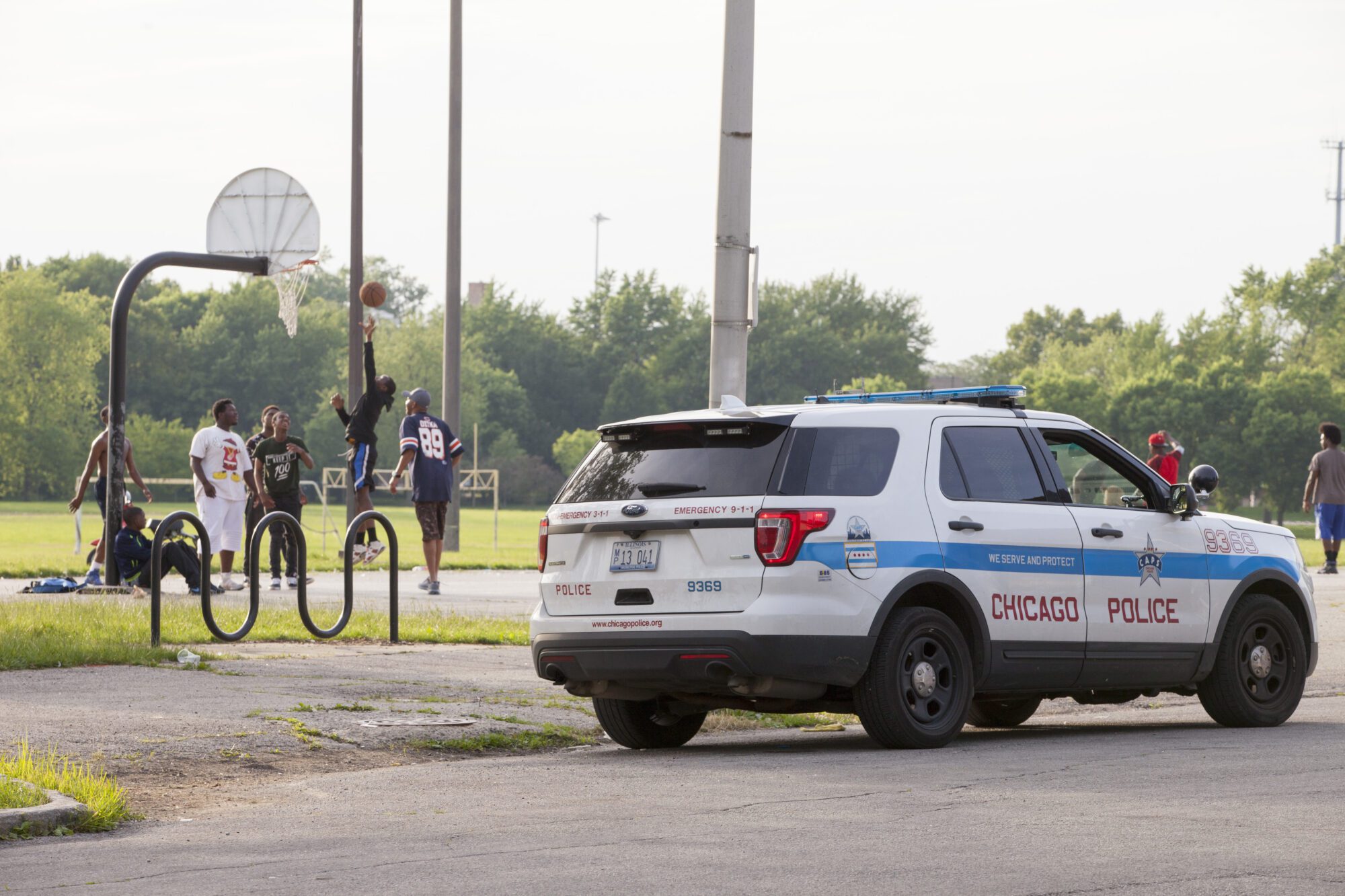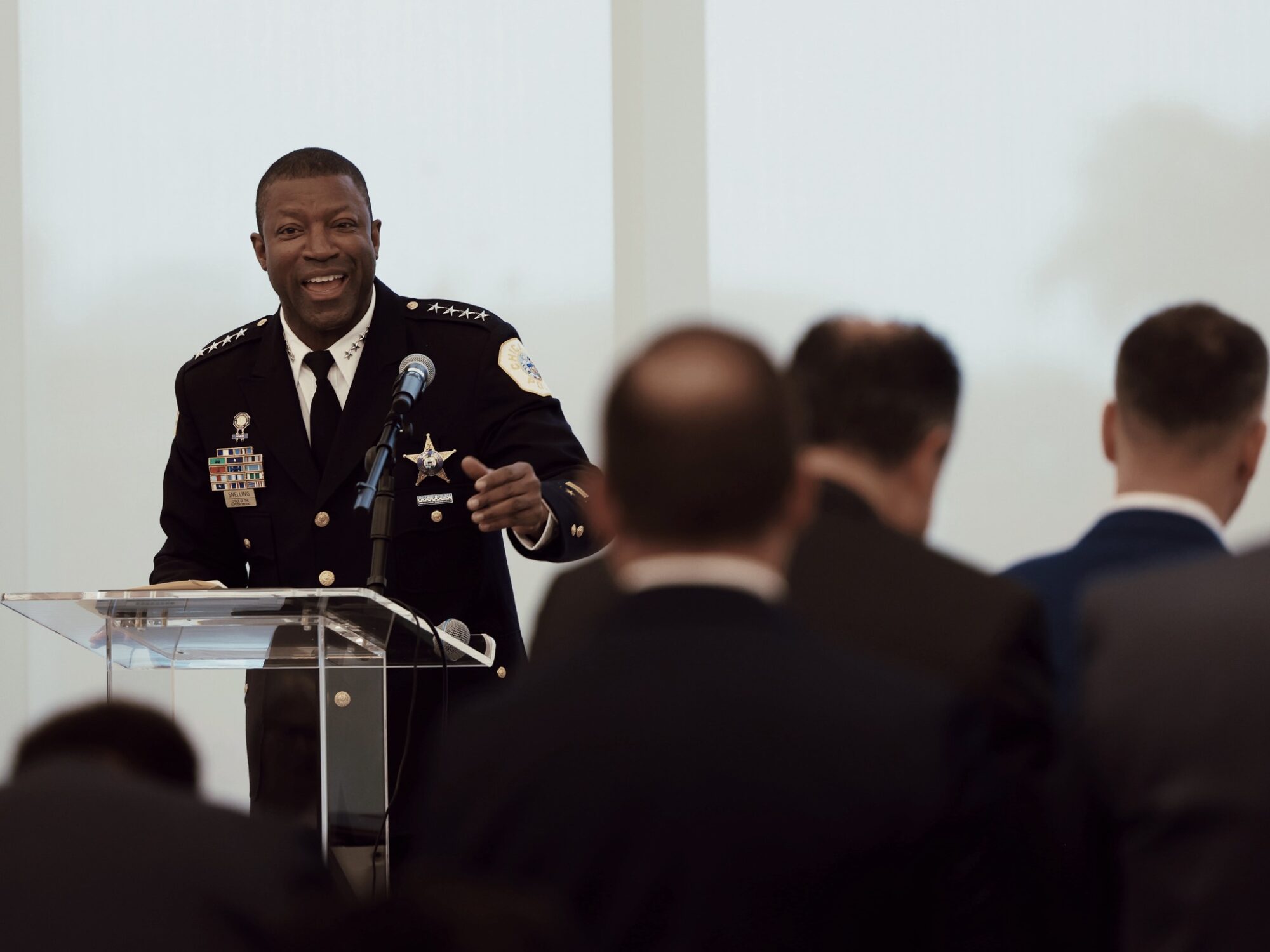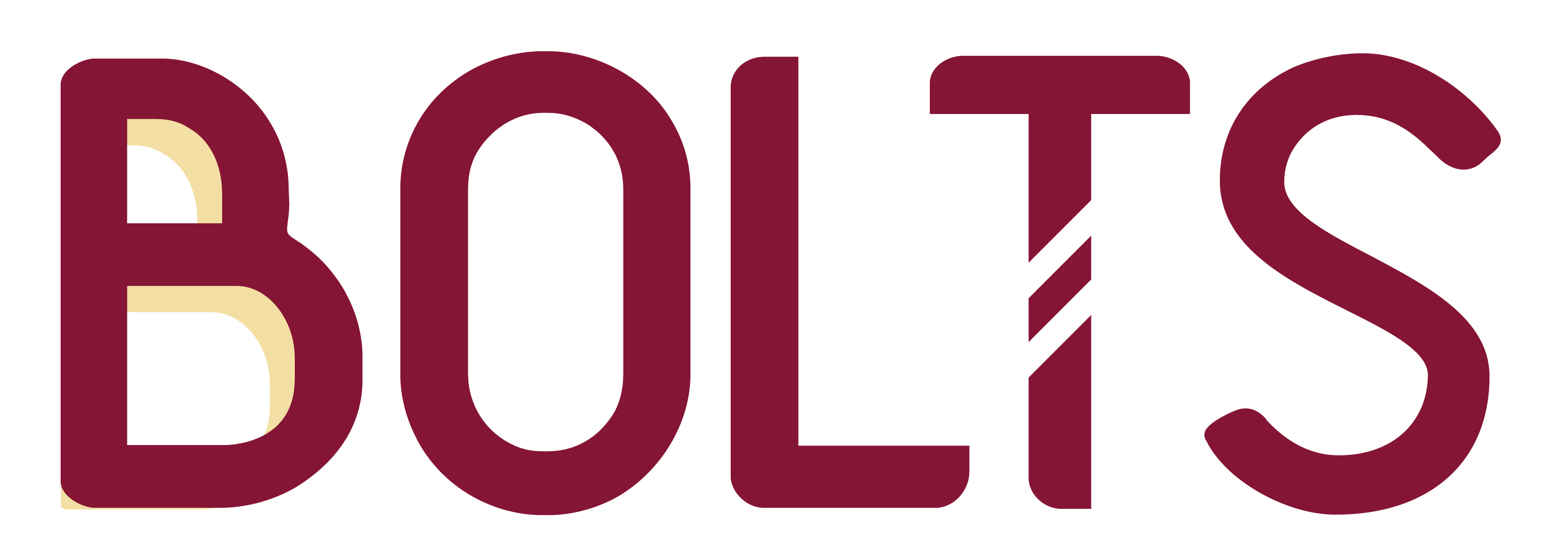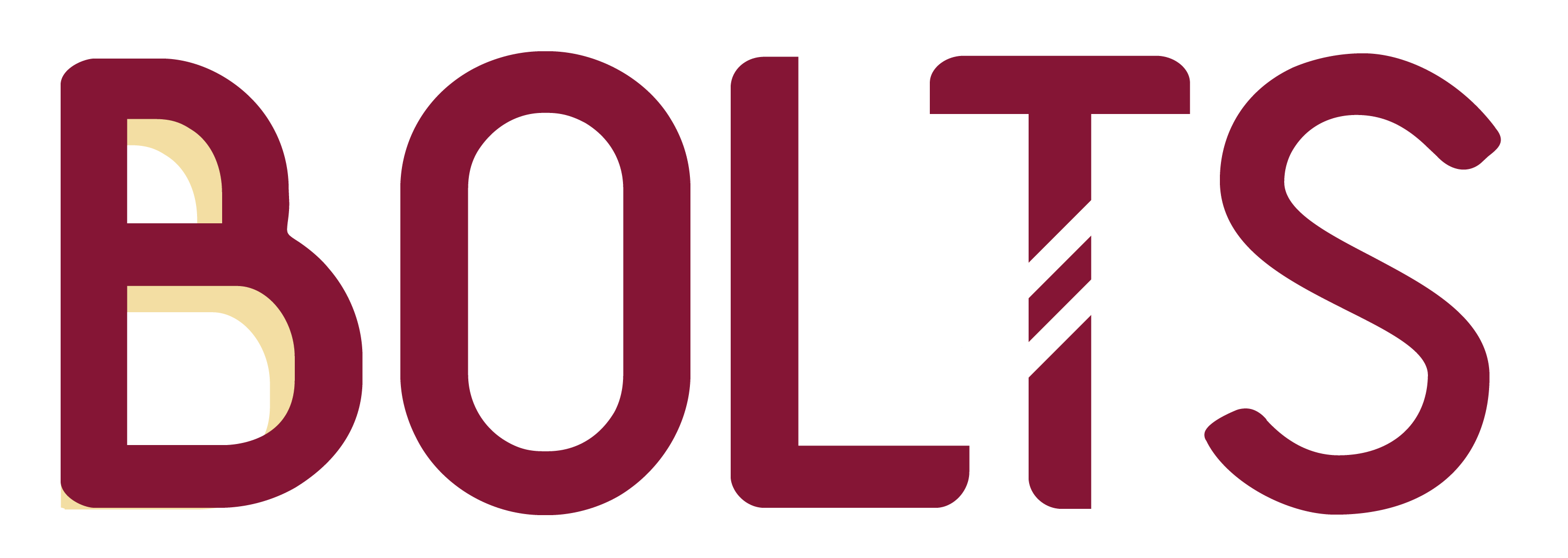“I’m Just Another Traffic Stop”
Chicago built a new police team to rebuild community trust. It harassed drivers of color instead.
Pascal Sabino | December 4, 2023


It had been a year since a federal judge ordered the city of Chicago to overhaul its police department. The requirement was to address discriminatory policing and misconduct that had decimated public faith in law enforcement, and progress was slow. But in summer 2020, the recently appointed Superintendent David Brown announced a new direction in public safety that promised to strengthen the bond between police and the communities they serve.
At the core of this community-centric policing strategy was a newly minted unit, the Community Safety Team. Brown said their mission would be getting to know neighbors, partnering with local churches, block clubs and businesses, and empowering residents to guide law enforcement’s crime priorities and solutions to neighborhood safety issues.
“The only way to create safer communities is one neighborhood at a time,” Brown said at the July 2020 announcement of the new team.
But rather than police encounters aimed at building community trust, data show the Community Safety Team, which quickly grew to over 800 officers in less than a year, focused instead on interactions known to harm community relations: hundreds of thousands of traffic stops.
The Community Safety Team was responsible for nearly a third of all traffic stops citywide by 2021, more than any other police team. Community Safety officers overwhelmingly stopped drivers in Black neighborhoods on the South and West Sides, contributing to massive racial disparities in traffic enforcement, data show.
Police accountability watchdogs say the Community Safety Team’s conduct reveals a pattern of the Chicago Police Department (CPD) hiding aggressive tactics beneath a veneer of community policing. In the past, CPD’s most aggressive units made heavy use of stop-and-frisk encounters to search people for drugs and weapons. But since a 2015 lawsuit led to major reforms of the practice, CPD replaced stop-and-frisk with stopping exponentially more motorists.
Now, despite a new progressive mayor’s outspoken stances against such notoriously harmful policing practices, and a newly confirmed police superintendent signaling a decisive shift in public safety strategy, many doubt whether the department can course-correct to an earnest community policing model.
“The city has a horrific history of these roving, violent citywide teams…that racially profile people and terrorize and physically brutalize people,” said Alexandra Block, Director of Criminal Legal Systems and Policing Project for the American Civil Liberties Union of Illinois. “The Community Safety Team is just an outcrop of that pattern.”
When drivers believe they are stopped and searched by police without reason, the feeling of harassment only deepens the divide between police and the communities they patrol, said Joseph Williams, member of the Englewood Police District Council, one of the civilian oversight bodies recently created to enhance community partnership and accountability.
“There’s no way you can do community policing while you’re doing all those stops,” Williams said. “You make them feel like less than a human being. They leave feeling worthless, like they’ve been targeted. I know what I felt like when I went through that.”
When Williams, 34, was pulled over most recently in July, the stop was relatively uneventful, and officers let him go without a search. But each of the countless traffic stops he endured still reminds him of a traumatic incident when he and a group of friends were pulled over as teens.
As the officers searched the group without their consent looking for illegal guns, they violated and humiliated the teenagers, Williams said.
“I’ll never forget them pulling me and my friends right out of the car and searching us,” Williams said. “They reached down into my private parts, went into our boxers, and they didn’t find anything. …We were young and glad we were let go, but ultimately that was a traumatic experience.”
The Community Safety Team
As the department poured resources into the Community Safety Team, Brown pledged their work would be driven by long-term relationships with residents, businesses, religious organizations and neighborhood groups.
By the end of 2020, the Community Safety Teams logged over 200 of those community interactions, according to a Bolts analysis of data from the Office of Emergency Management and Communications’ dispatch system, which generates a unique record each time officers radio headquarters to document civilian interactions or routine activities. Those community interactions included food drives, youth sports events and community input meetings, according to a Chicago police spokesperson.
But those interactions were dwarfed by the 48,000 traffic stops the team conducted in 2020—nearly all of that unit’s documented activity that year. In 2021, when the Community Safety Team was at its largest, its officers logged over 150,000 traffic stops—more than twice the number of community engagement activities, the data show.
Although the Community Safety Team was called a “first-of-its-kind approach designed for officers to get to know the people and places within each of the unique neighborhoods," Brown’s promises were reminiscent of a different community policing initiative launched in the 1990s, the Chicago Alternative Policing Strategy, or CAPS.
The CAPS approach was a hyper-local, bottom-up strategy that hinged on residents working with officers to identify both the issues in the community as well as potential solutions. The strategy worked to increase trust in police because the same officers had a consistent beat in a particular geographic area where residents could get to know them personally and officers could get familiar with the safety challenges in a small area, proponents said.
In the Englewood neighborhood on the city’s south side, CAPS officers have helped by listening to people’s priorities and focusing on problem-solving rather than numbers, Williams said. For instance, when a group of abandoned cars on a city-owned vacant lot became a magnet for drug dealing and other crime, Williams told the local CAPS team that it was a serious problem for neighbors. Officers then quickly dealt with the issue, he said.
"They ticketed those cars and got them towed. The community's been trying to get that done for a year almost," Williams said. "Our CAPS department is phenomenal."
But the Community Safety Team turned out to be a somewhat opposite approach: rather than officers building relationships in consistent beats, it was a roving citywide unit with no direct ties to specific neighborhoods. And they employed the same tactics as the notorious strike forces and saturation teams— squads of officers used to flood areas with police activity.
The legal backlash
After Chicago police shifted away from widespread use of stop-and-frisk tactics in 2015 following an ACLU Illinois lawsuit over the practice, the number of traffic stops conducted across the entire department soared. Between 2015 and 2023, officers made over 4.5 million traffic stops, mostly in Black and Latinx neighborhoods, CPD data show. Nearly 900,000 of these stops were made in 2019 alone, and by then the Illinois chapter of the ACLU had again raised the alarm that the stops may be violating drivers’ civil rights.
This work culminated in a class action lawsuit filed in June 2023 against the city on behalf of Chicagoans claiming the traffic stop strategy routinely violated the rights of Black and Latinx drivers. It singled out the Community Safety Team for the tremendous volume of traffic stops it conducted, amounting to what the suit called Chicago Police's "mass traffic stop program."
The lawsuit claims this program relies on illegal quotas, and flooding Black and Latinx neighborhoods with police encounters to deter unrelated crime, using the pretext of traffic enforcement to search drivers for contraband—often without their consent. This racial profiling of drivers of color resulted in police "harassing hundreds of thousands of Black Chicagoans" annually, Block said.
Twenty-five-year-old West Side resident Mahari Bell joined the lawsuit after being stopped over 10 times in the past eight years. While some of the stops seemed harmless, others left him fearing for his life, Bell said.
"A lot of us are just tired. People don't want to be harassed by Chicago police," Bell said. "I was profiled, harassed, my rights are violated consistently. Nobody wants to live like that, especially in the city that they're from."
While driving for UberEats in May2022, Bell was pulled over downtown when officers accused him of cutting off another driver—a claim he contests. Just moments into the encounter, officers put Bell in handcuffs without any explanation. When they asked to search his car, Bell felt like he had no choice but to agree.
"It all happened so quick. There wasn't any need for a search or for handcuffs. The officer, he was very accusatory, so it was clear that it wasn't about traffic," Bell said. "I feel like if I would have said no, the stop could have been completely different. I could've spent the night in a holding cell."
But even when police encounters don’t escalate, being constantly pulled over makes Bell feel "belittled, degraded and ultimately disrespected," he said.
"It made me realize, I think a lot of officers in Chicago just don't care to be a part of the community. They don't care to offer their public service," Bell said. "Despite my intentions, despite who I am, I'm still just a statistic to CPD. Just another traffic stop that has to be done for their numbers."
The lawsuit is still in early stages, but its goal is to end citywide units dedicated to traffic stops so Chicago Police can reel in the harm to community trust inflicted by the Community Safety Team and affiliated units, Block said.
"We are hoping CPD will rethink its reliance on the mass traffic stops strategy as its go-to supposed crime fighting technique, because it just doesn't work," Block said.
The ACLU's class action lawsuit builds upon an existing complaint about the Community Safety Team that came from within the unit itself. In 2021, Franklin Paz, a former lieutenant on the Community Safety Team sued the city over illegal traffic stop quotas. Paz, who was also a 20-year department veteran, claims he was demoted and punished for resisting the quotas.
Police sergeants on the Community Safety Team testified that when they were assigned to the unit, leadership told them their primary mission was to stop masses of drivers and proactively initiate police encounters, court records show. Officers were required to meet stop quotas unrelated to crime levels or traffic safety, according to Paz, who was instructed to demand that each officer in his platoon conduct at least 10 traffic stops daily, the complaint shows.
The ACLU lawsuit references emails where CPD’s then second-in-command, Deputy Superintendent Ernest Cato, urges commanders to raise traffic enforcement numbers and "utilize traffic stops to address violence."
The lawsuits share common claims that the Community Safety Team was simply a rebrand and reshuffling of CPD's infamously aggressive saturation teams.
Though Brown promised at the launch of the Community Safety Team that "this is not a roving strike force like what CPD had in the past," officers testified that unit was staffed with personnel from tactical teams, gun teams, saturation teams, and other groups trained to aggressively stop residents, often while patrolling in plainclothes and in unmarked cars.
Bolts’ analysis of CPD attendance and assignment data supports this, showing that at least 45 of the sergeants leading the Community Safety Team in its first year were assigned to the community policing initiative immediately after leaving tactical teams.
A new administration, a new era for policing?
Amid the legal backlash, CPD quietly sunsetted the Community Safety Team by reassigning officers to other units en masse by the start of 2023, leaving fewer than a hundred officers on the team. After becoming police superintendent in September, Larry Snelling said during a police budget hearing that he has since “broken that team down” and reassigned the officers back to local districts.
But even as the Community Safety Team waned, the unit’s aggressive traffic stop tactics continued to be enforced by other officers, including those assigned to neighborhood districts where Snelling emphasized he would focus police resources, data show. The most recent dispatch data show the units stopping the largest numbers of drivers are now those assigned to local districts, including beat officers, tactical teams, and rapid response officers.
Snelling is one of the first major appointees of Mayor Brandon Johnson, a former teacher and union organizer who ran and won on a historically progressive platform, and has promised to chart a new course for public safety centered on community investment, not solely law enforcement power. Since taking office, Johnson has had to balance expectations from the progressives who put him in power with those of the police union which has been antagonistic from the start. One of Johnson’s first acts as mayor established an Office of Community Safety, charged with “dual responsibilities of leading a full force of government, rapid response to safety issues and developing community-driven strategies for addressing the root causes of harm,” a spokesperson for the mayor told Bolts.
With a progressive mayor at the helm, mounting pressure from newly created civilian oversight councils, and the weight of the consent decree bearing down, the pressure is also on Snelling to set policing policy that can move the dial on community safety without sacrificing public trust in law enforcement.
Historically, incoming CPD leadership inevitably launches a signature crimefighting initiative, like Brown’s Community Safety Team or former Superintendent Garry McCarthy’s use of the CompStat strategy that resembled broken-windows policing. And Snelling will likely follow the example of his predecessors with a signature community policing initiative, said CPD expert Wes Skogan, professor emeritus of political science at Northwestern University.
"My guess is Larry Snelling will invent a new acronym with a promise of a reinvigorated community policing program," Skogan said.
But like the exchange of officers between tactical teams and the Community Safety Team, a new name doesn’t guarantee any fundamental change in how residents are impacted by the policing tactics.
Unless new leadership focuses on safety "outcomes" like crime reduction rather than "inputs" like traffic stop numbers, the aggressive policing tactics will likely continue, said former interim Superintendent Charlie Beck, who in 2020 dramatically restructured the department by shifting officers out of citywide units and into neighborhood police districts.
"You get what you ask for. If you emphasize traffic stops as what you want, then you'll get them. Unfortunately, if you cast too wide a net when you do that, you can make people feel like they're under siege,” Beck said.


There is also broader skepticism over whether Johnson’s administration can effectively steer the department away from the domineering policing tactics that have landed the city in hot water time and again. Johnson has faced continued pressure over his increase of the police budget, his administration’s contract agreement with the Fraternal Order of Police that doubles annual pay raises and may weaken accountability processes for disciplinary cases, and his continued funding of the ShotSpotter gunshot detection technology despite prior vows to drop the controversial surveillance system.
But Johnson’s budget does offer a preview into the community investments aimed at tackling the root causes of crime, with $209 million going towards efforts like anti-violence programming, restorative justice, re-entry programs and gender-based violence prevention and intervention, a spokesman for the mayor said. The plan vastly expands staffing for public mental health clinics and mobile crisis response teams, which include social workers and addiction specialists who would respond to 911 calls in lieu of police during mental health emergencies. Johnson’s budget would also expand the city’s youth job programs, and includes investments to address the housing and homelessness crisis brought to the forefront by the influx of asylum seekers.
Johnson and Snelling have both touted plans to replace up to 400 officer roles with civilian positions, such as domestic violence advocates and workers assigned to the officer training academy.
“Having those civilian employees amongst us, it creates a better environment for the officers,” Snelling said. “It’s officers working with civilians, so we have a better understanding of the community and the community has a better understanding of us. It shows we can work in partnership with people who are not sworn members.”
Community policing
In spite of the Community Safety Team, some prior community policing efforts have forged strong connections between residents and officers, leaving some hopeful for the future. Snelling’s earlier efforts at building connections with Englewood residents made Williams optimistic about future community policing efforts, he said.
"He brought his tactical officers out—the ones who do a lot of the crazy stuff sometimes—he brought them out so they could get to know the community in a different way,” Williams said. “He's coming in, he's walking those streets, trying to build the relationships.”
A 2019 community policing project, the Chicago Neighborhood Policing Initiative (NPI), emulates CAPS by dedicating a group of officers in each district to build long-term relationships with residents and neighborhood groups and coordinate city resources to solve problems in the area. Unlike the Community Safety Team, these officers don’t do the typical emergency responses, traffic stops, and patrols.
The program has "reimagined what police officers can do," said Deondre' Rutues, a council member for the 15th Police District in Austin, as well as the Community Engagement Specialist for the Chicago Neighborhood Policing Initiative.
"We're supposed to lead the charge and tell them what we need from them," Rutues said. "It isn't a process where police just come and lock somebody up. The officers follow the lead of the community to determine what to do."
Changing police leadership, staffing shortages and the interruption of the coronavirus pandemic halted the NPI from being fully implemented, a Northwestern report found. But the success of the NPI shows that one arm of the city's agenda may be dedicated to an earnest attempt at community policing.
But as long as the other arm is focused on mass traffic stops conducted by roving strike teams, Chicago's community policing agenda will be at odds with itself, says Rutues.
"You created the Community Safety Team to enhance relationship building...But it continues to undo everything that is supposed to be contained in the Consent Decree, and also the work people on the ground are trying to do."
Stay up-to-date
Now is the best time to support Bolts
NewsMatch is matching all donations (up to $1,000) through the end of the year. Support our nonprofit newsroom today.


